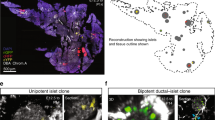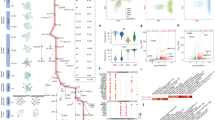Abstract
Insulin from the β-cells of the pancreatic islets of Langerhans controls energy homeostasis in vertebrates, and its deficiency causes diabetes mellitus. During embryonic development, the transcription factor neurogenin 3 (Neurog3) initiates the differentiation of the β-cells and other islet cell types from pancreatic endoderm, but the genetic program that subsequently completes this differentiation remains incompletely understood. Here we show that the transcription factor Rfx6 directs islet cell differentiation downstream of Neurog3. Mice lacking Rfx6 failed to generate any of the normal islet cell types except for pancreatic-polypeptide-producing cells. In human infants with a similar autosomal recessive syndrome of neonatal diabetes, genetic mapping and subsequent sequencing identified mutations in the human RFX6 gene. These studies demonstrate a unique position for Rfx6 in the hierarchy of factors that coordinate pancreatic islet development in both mice and humans. Rfx6 could prove useful in efforts to generate β-cells for patients with diabetes.
This is a preview of subscription content, access via your institution
Access options
Subscribe to this journal
Receive 51 print issues and online access
$199.00 per year
only $3.90 per issue
Buy this article
- Purchase on Springer Link
- Instant access to full article PDF
Prices may be subject to local taxes which are calculated during checkout





Similar content being viewed by others
References
Murtaugh, L. C. Pancreas and beta-cell development: from the actual to the possible. Development 134, 427–438 (2007)
Gradwohl, G., Dierich, A., LeMeur, M. & Guillemot, F. neurogenin3 is required for the development of the four endocrine cell lineages of the pancreas. Proc. Natl Acad. Sci. USA 97, 1607–1611 (2000)
Apelqvist, A. et al. Notch signalling controls pancreatic cell differentiation. Nature 400, 877–881 (1999)
Schwitzgebel, V. M. et al. Expression of neurogenin3 reveals an islet cell precursor population in the pancreas. Development 127, 3533–3542 (2000)
McCarthy, M. I. & Hattersley, A. T. Learning from molecular genetics: novel insights arising from the definition of genes for monogenic and type 2 diabetes. Diabetes 57, 2889–2898 (2008)
Miyatsuka, T., Li, Z. & German, M. S. Chronology of islet differentiation revealed by temporal cell labeling. Diabetes 58, 1863–1868 (2009)
Gasa, R. et al. Induction of pancreatic islet cell differentiation by the neurogenin-neuroD cascade. Differentiation 76, 381–391 (2008)
Aftab, S., Semenec, L., Chu, J. S. & Chen, N. Identification and characterization of novel human tissue-specific RFX transcription factors. BMC Evol. Biol. 8, 226 (2008)
Emery, P., Durand, B., Mach, B. & Reith, W. RFX proteins, a novel family of DNA binding proteins conserved in the eukaryotic kingdom. Nucleic Acids Res. 24, 803–807 (1996)
Lee, C. S., Perreault, N., Brestelli, J. E. & Kaestner, K. H. Neurogenin 3 is essential for the proper specification of gastric enteroendocrine cells and the maintenance of gastric epithelial cell identity. Genes Dev. 16, 1488–1497 (2002)
Soriano, P. Generalized lacZ expression with the ROSA26 Cre reporter strain. Nature Genet. 21, 70–71 (1999)
Ait-Lounis, A. et al. Novel function of the ciliogenic transcription factor RFX3 in development of the endocrine pancreas. Diabetes 56, 950–959 (2007)
Rual, J. F. et al. Towards a proteome-scale map of the human protein-protein interaction network. Nature 437, 1173–1178 (2005)
Emery, P. et al. A consensus motif in the RFX DNA binding domain and binding domain mutants with altered specificity. Mol. Cell. Biol. 16, 4486–4494 (1996)
Cano, D. A., Sekine, S. & Hebrok, M. Primary cilia deletion in pancreatic epithelial cells results in cyst formation and pancreatitis. Gastroenterology 131, 1856–1869 (2006)
Cano, D. A., Murcia, N. S., Pazour, G. J. & Hebrok, M. Orpk mouse model of polycystic kidney disease reveals essential role of primary cilia in pancreatic tissue organization. Development 131, 3457–3467 (2004)
Mitchell, J. et al. Neonatal diabetes, with hypoplastic pancreas, intestinal atresia and gall bladder hypoplasia: search for the aetiology of a new autosomal recessive syndrome. Diabetologia 47, 2160–2167 (2004)
Chappell, L. et al. A further example of a distinctive autosomal recessive syndrome comprising neonatal diabetes mellitus, intestinal atresias and gall bladder agenesis. Am. J. Med. Genet. A. 146A, 1713–1717 (2008)
Liu, X., Yu, X., Zack, D. J., Zhu, H. & Qian, J. TiGER: a database for tissue-specific gene expression and regulation. BMC Bioinformatics 9, 271 (2008)
Stefan, Y., Grasso, S., Perrelet, A. & Orci, L. A quantitative immunofluorescent study of the endocrine cell populations in the developing human pancreas. Diabetes 32, 293–301 (1983)
Lyttle, B. M. et al. Transcription factor expression in the developing human fetal endocrine pancreas. Diabetologia 51, 1169–1180 (2008)
Hodges, E. et al. Genome-wide in situ exon capture for selective resequencing. Nature Genet. 39, 1522–1527 (2007)
Karolchik, D. et al. The UCSC Genome Browser Database: 2008 update. Nucleic Acids Res. 36, D773–D779 (2008)
Albert, T. J. et al. Direct selection of human genomic loci by microarray hybridization. Nature Methods 4, 903–905 (2007)
Gajiwala, K. S. et al. Structure of the winged-helix protein hRFX1 reveals a new mode of DNA binding. Nature 403, 916–921 (2000)
Chang, Y. F., Imam, J. S. & Wilkinson, M. F. The nonsense-mediated decay RNA surveillance pathway. Annu. Rev. Biochem. 76, 51–74 (2007)
Gentile, M. & Fiorente, P. Esophageal, duodenal, rectoanal and biliary atresia, intestinal malrotation, malformed/hypoplastic pancreas, and hypospadias: further evidence of a new distinct syndrome. Am. J. Med. Genet. 87, 82–83 (1999)
Hakonarson, H. et al. A novel susceptibility locus for type 1 diabetes on Chr12q13 identified by a genome-wide association study. Diabetes 57, 1143–1146 (2008)
Sladek, R. et al. A genome-wide association study identifies novel risk loci for type 2 diabetes. Nature 445, 881–885 (2007)
The Wellcome Trust Case Control Consortium.Genome-wide. association study of 14,000 cases of seven common diseases and 3,000 shared controls. Nature 447, 661–678 (2007)
Wang, J. et al. Mutant neurogenin-3 in congenital malabsorptive diarrhea. N. Engl. J. Med. 355, 270–280 (2006)
Jensen, J. et al. Independent development of pancreatic alpha- and beta-cells from neurogenin3-expressing precursors: a role for the notch pathway in repression of premature differentiation. Diabetes 49, 163–176 (2000)
Gu, G., Dubauskaite, J. & Melton, D. A. Direct evidence for the pancreatic lineage: NGN3+ cells are islet progenitors and are distinct from duct progenitors. Development 129, 2447–2457 (2002)
Cortina, G. et al. Enteroendocrine cell dysgenesis and malabsorption, a histopathologic and immunohistochemical characterization. Hum. Pathol. 38, 570–580 (2007)
Jensen, J. N. et al. Mutant neurogenin-3 in congenital malabsorptive diarrhea. N. Engl. J. Med. 356, 1781–1782; author reply 1782 (2007)
Wang, S. et al. Myt1 and Ngn3 form a feed-forward expression loop to promote endocrine islet cell differentiation. Dev. Biol. 317, 531–540 (2008)
Copeland, N. G., Jenkins, N. A. & Court, D. L. Recombineering: a powerful new tool for mouse functional genomics. Nature Rev. Genet. 2, 769–779 (2001)
Nekrep, N., Wang, J., Miyatsuka, T. & German, M. S. Signals from the neural crest regulate beta-cell mass in the pancreas. Development 135, 2151–2160 (2008)
Lynn, F. C. et al. MicroRNA expression is required for pancreatic islet cell genesis in the mouse. Diabetes 56, 2938–2945 (2007)
Lynn, F. C. et al. Sox9 coordinates a transcriptional network in pancreatic progenitor cells. Proc. Natl Acad. Sci. USA 104, 10500–10505 (2007)
Steemers, F. J. & Gunderson, K. L. Whole genome genotyping technologies on the BeadArray platform. Biotechnol. J. 2, 41–49 (2007)
David, E., Garcia, A. D. & Hearing, P. Interaction of EF-C/RFX-1 with the inverted repeat of viral enhancer regions is required for transactivation. J. Biol. Chem. 270, 8353–8360 (1995)
Acknowledgements
We thank all the patients and their families for the participation in this study and P. Riley for allowing us access to her clinical data. We thank G. Grodsky, G. Bell, W. Rutter, R. Gasa and members of the German laboratory for discussions, F. Schaufle and the DERC Microscopy Core Laboratory, C. Mrejen and the UCSF DERC Genomics Core, N. Killeen and the UCSF DERC Transgenic Core Laboratory for help with the generation of the Rfx6-targeted mice, R. Koshy for technical assistance, Y. Zhang and S. Zhao for assistance with mouse husbandry and genotyping, the Massively Parallel Sequencing team at the McGill University and Genome Quebec Innovation Center for DNA sequencing and J. Wasserscheid for bioinformatics analyses. This work was supported by grants from the Larry L. Hillblom Foundation (S.B.S. and M.S.G.), the Juvenile Diabetes Research Foundation (S.B.S., F.C.L., T.M., R.W., C.P. and M.S.G.), the American Diabetes Association (M.S.G.), the Nora Eccles Treadwell Foundation (M.S.G.), the Canadian Institutes of Health Research (H.-Q.Q.), and the National Institutes of Health/National Institute of Diabetes and Digestive and Kidney Diseases (M.S.G.).
Author Contributions S.B.S., H.-Q.Q., N.T., N.Y.K., D.W.S., F.C.L., K.D., R.W., C.P. and M.S.G. wrote the paper. K.D., C.P. and M.S.G. oversaw the studies. S.B.S., D.W.S., Y.L., J.Wa., T.M., R.W., M.-E.W. and J.D.J. performed mRNA expression analyses. N.Y.K., D.W.S. and J.Wa. performed immunofluorescence studies. S.B.S., F.C.L. and R.S. performed Rfx6 gene targeting studies. S.B.S. performed DNA binding and transcription studies. H.-Q.Q. performed homozygosity mapping. N.T., R.G., K.D. and J.Wa. performed Nimblegen array and sequencing studies. A.-M.P., J.M, J.D, S.V.E., M.A., N.Ka., J.We., M.-E.R., M.G., I.H. and A.T.H. recruited the human subjects and provided phenotypic information. H.-Q.Q. and N.T. contributed equally to this work; N.Y.K. and D.W.S. contributed equally to this work.
Author information
Authors and Affiliations
Corresponding authors
Ethics declarations
Competing interests
Competing interests: M.S.G. is an inventor on patents held by the University of California covering Neurog3 and its use.
Supplementary information
Supplementary Information
This file contains Supplementary Figures S1-S17 with Legends, Supplementary Notes for the Human Mapping and Supplementary Tables S1-S5 and S7-S8. (PDF 7605 kb)
Supplementary Table S6
This table shows the expression of genes in the region of homozygosity by descent. (XLS 396 kb)
Rights and permissions
About this article
Cite this article
Smith, S., Qu, HQ., Taleb, N. et al. Rfx6 directs islet formation and insulin production in mice and humans. Nature 463, 775–780 (2010). https://doi.org/10.1038/nature08748
Received:
Accepted:
Issue Date:
DOI: https://doi.org/10.1038/nature08748
This article is cited by
-
ISL1 controls pancreatic alpha cell fate and beta cell maturation
Cell & Bioscience (2023)
-
Single cell multiomic analysis reveals diabetes-associated β-cell heterogeneity driven by HNF1A
Nature Communications (2023)
-
Monogenic diabetes
Nature Reviews Disease Primers (2023)
-
The genetics of monogenic intestinal epithelial disorders
Human Genetics (2023)
-
Genetic risk converges on regulatory networks mediating early type 2 diabetes
Nature (2023)
Comments
By submitting a comment you agree to abide by our Terms and Community Guidelines. If you find something abusive or that does not comply with our terms or guidelines please flag it as inappropriate.



